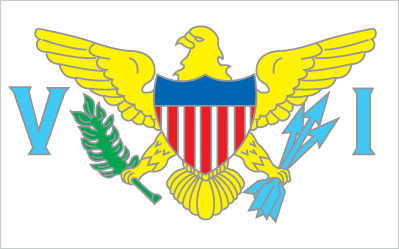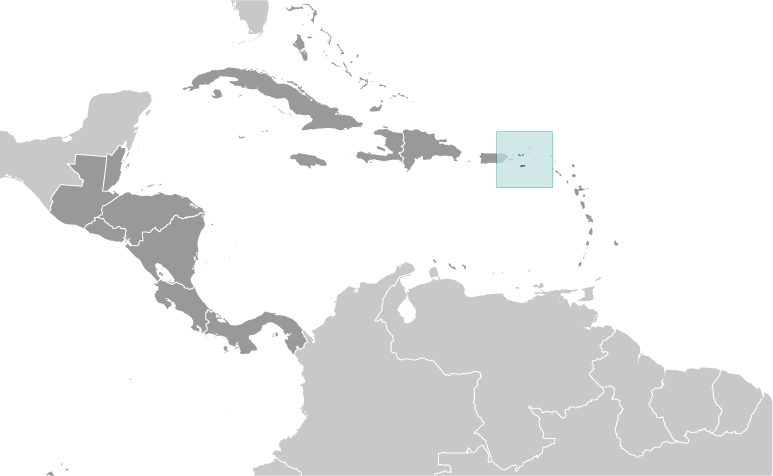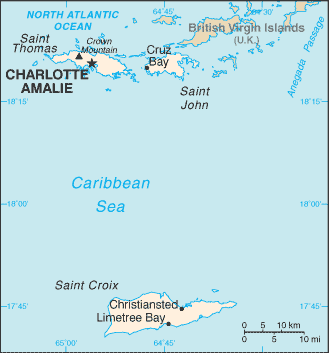


-
Introduction :: Virgin Islands
-
Background:The Danes secured control over the southern Virgin Islands of Saint Thomas, Saint John, and Saint Croix during the 17th and early 18th centuries. Sugarcane, produced by African slave labor, drove the islands' economy during the 18th and early 19th centuries. In 1917, the US purchased the Danish holdings, which had been in economic decline since the abolition of slavery in 1848. On 6 September 2017, Hurricane Irma passed over the northern Virgin Islands of Saint Thomas and Saint John and inflicted severe damage to structures, roads, the airport on Saint Thomas, communications, and electricity. Less than two weeks later, Hurricane Maria passed over the island of Saint Croix in the southern Virgin Islands, inflicting considerable damage with heavy winds and flooding rains.
-
Geography :: Virgin Islands
-
Location:Caribbean, islands between the Caribbean Sea and the North Atlantic Ocean, east of Puerto RicoGeographic coordinates:18 20 N, 64 50 WMap references:Central America and the CaribbeanArea:total: 1,910 sq kmland: 346 sq kmwater: 1,564 sq kmcountry comparison to the world: 182Area - comparative:twice the size of Washington, DCLand boundaries:0 kmCoastline:188 kmMaritime claims:territorial sea: 12 nmexclusive economic zone: 200 nmClimate:subtropical, tempered by easterly trade winds, relatively low humidity, little seasonal temperature variation; rainy season September to NovemberTerrain:mostly hilly to rugged and mountainous with little flat landElevation:lowest point: Caribbean Sea 0 mhighest point: Crown Mountain 474 mNatural resources:pleasant climate, beaches foster tourismLand use:agricultural land: 11.5% (2011 est.)arable land: 2.9% (2011 est.) / permanent crops: 2.9% (2011 est.) / permanent pasture: 5.7% (2011 est.)forest: 57.4% (2011 est.)other: 31.1% (2011 est.)Irrigated land:1 sq km (2012)Population distribution:while overall population density throughout the islands is relatively low, concentrations appear around Charlotte Amalie on St. Thomas and Christiansted on St. CroixNatural hazards:several hurricanes in recent years; frequent and severe droughts and floods; occasional earthquakesEnvironment - current issues:lack of natural freshwater resources; protection of coral reefs; solid waste management; coastal development; increased boating and overfishingGeography - note:important location along the Anegada Passage - a key shipping lane for the Panama Canal; Saint Thomas has one of the best natural deepwater harbors in the Caribbean
-
People and Society :: Virgin Islands
-
Population:106,977 (July 2018 est.)country comparison to the world: 192Nationality:noun: Virgin Islander(s) (US citizens)adjective: Virgin IslanderEthnic groups:black 76%, white 15.6%, Asian 1.4%, other 4.9%, mixed 2.1% (2010 est.)
note: 17.4% self-identify as latino
Languages:English 71.6%, Spanish or Spanish Creole 17.2%, French or French Creole 8.6%, other 2.5% (2010 est.)Religions:Protestant 59% (Baptist 42%, Episcopalian 17%), Roman Catholic 34%, other 7%Age structure:0-14 years: 20.26% (male 11,102 /female 10,570)15-24 years: 10.87% (male 5,665 /female 5,965)25-54 years: 36.87% (male 18,454 /female 20,987)55-64 years: 13.92% (male 7,039 /female 7,851)65 years and over: 18.08% (male 8,802 /female 10,542) (2018 est.)population pyramid: The World Factbook Field Image ModalCentral America :: Virgin Islands Print
The World Factbook Field Image ModalCentral America :: Virgin Islands Print Image DescriptionThis is the population pyramid for the Virgin Islands. A population pyramid illustrates the age and sex structure of a country's population and may provide insights about political and social stability, as well as economic development. The population is distributed along the horizontal axis, with males shown on the left and females on the right. The male and female populations are broken down into 5-year age groups represented as horizontal bars along the vertical axis, with the youngest age groups at the bottom and the oldest at the top. The shape of the population pyramid gradually evolves over time based on fertility, mortality, and international migration trends.
Image DescriptionThis is the population pyramid for the Virgin Islands. A population pyramid illustrates the age and sex structure of a country's population and may provide insights about political and social stability, as well as economic development. The population is distributed along the horizontal axis, with males shown on the left and females on the right. The male and female populations are broken down into 5-year age groups represented as horizontal bars along the vertical axis, with the youngest age groups at the bottom and the oldest at the top. The shape of the population pyramid gradually evolves over time based on fertility, mortality, and international migration trends.
For additional information, please see the entry for Population pyramid on the Definitions and Notes page under the References tab.Dependency ratios:total dependency ratio: 60.8 (2015 est.)youth dependency ratio: 32.8 (2015 est.)elderly dependency ratio: 28 (2015 est.)potential support ratio: 3.6 (2015 est.)Median age:total: 41.3 years (2018 est.)male: 40.1 yearsfemale: 42.2 yearscountry comparison to the world: 42Population growth rate:-0.3% (2018 est.)country comparison to the world: 217Birth rate:12.5 births/1,000 population (2018 est.)country comparison to the world: 155Death rate:8.1 deaths/1,000 population (2018 est.)country comparison to the world: 88Net migration rate:-7.5 migrant(s)/1,000 population (2018 est.)country comparison to the world: 209Population distribution:while overall population density throughout the islands is relatively low, concentrations appear around Charlotte Amalie on St. Thomas and Christiansted on St. CroixUrbanization:urban population: 95.8% of total population (2019)rate of urbanization: 0.1% annual rate of change (2015-20 est.)Major urban areas - population:52,000 CHARLOTTE AMALIE (capital) (2018)Sex ratio:at birth: 1.06 male(s)/female0-14 years: 1.05 male(s)/female15-24 years: 0.95 male(s)/female25-54 years: 0.88 male(s)/female55-64 years: 0.9 male(s)/female65 years and over: 0.83 male(s)/femaletotal population: 0.91 male(s)/female (2018 est.)Infant mortality rate:total: 7.7 deaths/1,000 live births (2018 est.)male: 8.8 deaths/1,000 live birthsfemale: 6.7 deaths/1,000 live birthscountry comparison to the world: 158Life expectancy at birth:total population: 79.5 years (2018 est.)male: 76.3 yearsfemale: 83 yearscountry comparison to the world: 49Total fertility rate:2.06 children born/woman (2018 est.)country comparison to the world: 108Drinking water source:improved: urban: 100% of populationrural: 100% of populationtotal: 100% of populationunimproved: urban: 0% of populationrural: 0% of populationtotal: 0% of population (2015 est.)Sanitation facility access:improved: urban: 96.4% of population (2015 est.)rural: 96.4% of population (2015 est.)total: 96.4% of population (2015 est.)unimproved: urban: 3.6% of population (2015 est.)rural: 3.6% of population (2015 est.)total: 3.6% of population (2015 est.)HIV/AIDS - adult prevalence rate:NAHIV/AIDS - people living with HIV/AIDS:NAHIV/AIDS - deaths:NAMajor infectious diseases:note: active local transmission of Zika virus by Aedes species mosquitoes has been identified in this country (as of August 2016); it poses an important risk (a large number of cases possible) among US citizens if bitten by an infective mosquito; other less common ways to get Zika are through sex, via blood transfusion, or during pregnancy, in which the pregnant woman passes Zika virus to her fetus
Education expenditures:NA -
Government :: Virgin Islands
-
Country name:conventional long form: noneconventional short form: Virgin Islandsformer: Danish West Indiesabbreviation: VIetymology: the myriad islets, cays, and rocks surrounding the major islands reminded Christopher COLUMBUS in 1493 of Saint Ursula and her 11,000 virgin followers (Santa Ursula y las Once Mil Virgenes), which over time shortened to the Virgins (las Virgenes)Dependency status:unincorporated organized territory of the US with policy relations between the Virgin Islands and the federal government under the jurisdiction of the Office of Insular Affairs, US Department of the InteriorGovernment type:republican form of government with separate executive, legislative, and judicial branches; unincorporated organized territory of the US with local self-governmentCapital:name: Charlotte Amaliegeographic coordinates: 18 21 N, 64 56 Wtime difference: UTC-4 (1 hour ahead of Washington, DC, during Standard Time)Administrative divisions:none (territory of the US); there are no first-order administrative divisions as defined by the US Government, but there are 3 islands at the second order; Saint Croix, Saint John, Saint ThomasIndependence:none (territory of the US)National holiday:Transfer Day (from Denmark to the US), 31 March (1917)Constitution:history: 22 July 1954 - the Revised Organic Act of the Virgin Islands functions as a constitution for this US territoryamendments: revised 1962, 2000 (2018)Legal system:US common lawCitizenship:see United StatesSuffrage:18 years of age; universal; note - island residents are US citizens but do not vote in US presidential electionsExecutive branch:chief of state: President Donald J. TRUMP (since 20 January 2017); Vice President Michael R. PENCE (since 20 January 2017)head of government: Governor Albert BRYAN, Jr. (since 7 January 2019), Lieutenant Governor Tregenza ROACH (since 7 January 2019)cabinet: Territorial Cabinet appointed by the governor and confirmed by the Senateelections/appointments: president and vice president indirectly elected on the same ballot by an Electoral College of 'electors' chosen from each state; president and vice president serve a 4-year term (eligible for a second term); under the US Constitution, residents of the Virgin Islands do not vote in elections for US president and vice president; however, they may vote in the Democratic and Republican presidential primary elections; governor and lieutenant governor directly elected on the same ballot by absolute majority vote in 2 rounds if needed for a 4-year term (eligible for a second term); election last held on 6 November 2018 with a runoff on 20 November 2018 (next to be held in November 2022)election results:
Albert BRYAN, Jr. elected governor in the second round; percent of vote in first round - Albert BRYAN, Jr. (Democratic Party) 38.1%, Kenneth MAPP (independent) 33.5%, Adlah "Foncie" DONASTORG, Jr. (independent) 16.5%, other 11.9%; percent of vote in second round- Albert BRYAN, Jr. (Democratic Party) 54.5%, Kenneth MAPP (independent) 45.2%, other .3%
Legislative branch:description: unicameral Legislature of the Virgin Islands (15 seats; senators directly elected in single- and multi-seat constituencies by simple majority popular vote to serve 2-year terms)
the Virgin Islands directly elects 1 delegate to the US House of Representatives by simple majority vote to serve a 2-year termelections: Legislature of the Virgin Islands last held on 6 November 2018 (next to be held in November 2020)
US House of Representatives last held on 6 November 2018 (next to be held in November 2020)election results: Legislature of the Virgin Islands - percent of vote by party - NA; seats by party - Democratic Party 13, independents 2; composition - men 11, women 4, percent of women 26.7%
delegate to US House of Representatives - seat by party - Democratic Party 1; composition - 1 womannote: the Virgin Islands to the US House of Representatives can vote when serving on a committee and when the House meets as the Committee of the Whole House, but not when legislation is submitted for a “full floor” House vote
Judicial branch:highest courts: Supreme Court of the Virgin Islands (consists of the chief justice and 2 associate justices); note - court established by the US Congress in 2004 and assumed appellate jurisdiction in 2007judge selection and term of office: justices appointed by the governor and confirmed by the Virgin Islands Senate; justices serve initial 10-year terms and upon reconfirmation, during the extent of good behavior; chief justice elected to position by peers for a 3-year termsubordinate courts: Superior Court (Territorial Court renamed in 2004); US Court of Appeals for the Third Circuit (has appellate jurisdiction over the District Court of the Virgin Islands; it is a territorial court and is not associated with a US federal judicial district); District Court of the Virgin IslandsPolitical parties and leaders:Democratic Party [Donna M. CHRISTENSEN]
Independent Citizens' Movement or ICM [Dale BLYDEN]
Republican Party [John CANEGATA]International organization participation:AOSIS (observer), Interpol (subbureau), IOC, UPU, WFTU (NGOs)Diplomatic representation in the US:none (territory of the US)Diplomatic representation from the US:none (territory of the US)Flag description:white field with a modified US coat of arms in the center between the large blue initials V and I; the coat of arms shows a yellow eagle holding an olive branch in its right talon and three arrows in the left with a superimposed shield of seven red and six white vertical stripes below a blue panel; white is a symbol of purity, the letters stand for the Virgin IslandsNational anthem:name: Virgin Islands Marchlyrics/music: multiple/Alton Augustus ADAMS, Sr.note: adopted 1963; serves as a local anthem; as a territory of the US, "The Star-Spangled Banner" is official (see United States)
-
Economy :: Virgin Islands
-
Economy - overview:
Tourism, trade, other services, and rum production are the primary economic activities of the US Virgin Islands (USVI), accounting for most of its GDP and employment. The USVI receives between 2.5 and 3 million tourists a year, mostly from visiting cruise ships. The islands are vulnerable to damage from storms, as evidenced by the destruction from two major hurricanes in 2017. Recovery and rebuilding have continued, but full recovery from these back-to-back hurricanes is years away. The USVI government estimates it will need $7.5 billion, almost twice the territory’s GDP, to rebuild the territory.
The agriculture sector is small and most food is imported. In 2016, government spending (both federal and territorial together) accounted for about 27% of GDP while exports of goods and services, including spending by tourists, accounted for nearly 47%. Federal programs and grants, including rum tax cover-over totaling $482.3 million in 2016, contributed 32.2% of the territory’s total revenues. The economy picked up 0.9% in 2016 and had appeared to be progressing before the 2017 hurricanes severely damaged the territory’s infrastructure and the economy.
GDP (purchasing power parity):$3.872 billion (2016 est.)$3.759 billion (2015 est.)$3.622 billion (2014 est.)note: data are in 2013 dollars
country comparison to the world: 181GDP (official exchange rate):$5.182 billion (2016 est.) (2016 est.)GDP - real growth rate:0.9% (2016 est.)0.3% (2015 est.)-1% (2014 est.)country comparison to the world: 185GDP - per capita (PPP):$37,000 (2016 est.)$35,800 (2015 est.)$34,500 (2014 est.)country comparison to the world: 54GDP - composition, by end use:household consumption: 68.2% (2016 est.)government consumption: 26.8% (2016 est.)investment in fixed capital: 7.5% (2016 est.)investment in inventories: 15% NA (2016 est.)exports of goods and services: 46.7% (2016 est.)imports of goods and services: -64.3% (2016 est.)GDP - composition, by sector of origin:agriculture: 2% (2012 est.)industry: 20% (2012 est.)services: 78% (2012 est.)Agriculture - products:fruit, vegetables, sorghum; Senepol cattleIndustries:tourism, watch assembly, rum distilling, construction, pharmaceuticals, electronicsIndustrial production growth rate:NALabor force:48,550 (2016 est.)country comparison to the world: 193Labor force - by occupation:agriculture: 1%industry: 19%services: 80% (2003 est.)Unemployment rate:10.4% (2017 est.)11% (2016 est.)country comparison to the world: 145Population below poverty line:28.9% (2002 est.)Household income or consumption by percentage share:lowest 10%: NAhighest 10%: NABudget:revenues: 1.496 billion (2016 est.)expenditures: 1.518 billion (2016 est.)Taxes and other revenues:28.9% (of GDP) (2016 est.)country comparison to the world: 89Budget surplus (+) or deficit (-):-0.4% (of GDP) (2016 est.)country comparison to the world: 59Public debt:53.3% of GDP (2016 est.)45.9% of GDP (2014 est.)country comparison to the world: 91Fiscal year:1 October - 30 SeptemberInflation rate (consumer prices):1% (2016 est.)2.6% (2015 est.)country comparison to the world: 54Exports:$1.81 billion (2016 est.)$1.537 billion (2015 est.)country comparison to the world: 147Exports - commodities:rumImports:$2.489 billion (2016 est.)$1.549 billion (2015 est.)country comparison to the world: 159Imports - commodities:foodstuffs, consumer goods, building materialsDebt - external:NA
Stock of direct foreign investment - at home:(31 December 2009 est.)Exchange rates:the US dollar is used
-
Energy :: Virgin Islands
-
Electricity access:electrification - total population: 100% (2016)Electricity - production:704 million kWh (2016 est.)country comparison to the world: 157Electricity - consumption:654.7 million kWh (2016 est.)country comparison to the world: 162Electricity - exports:0 kWh (2016 est.)country comparison to the world: 216Electricity - imports:0 kWh (2016 est.)country comparison to the world: 217Electricity - installed generating capacity:325,000 kW (2016 est.)country comparison to the world: 157Electricity - from fossil fuels:98% of total installed capacity (2016 est.)country comparison to the world: 30Electricity - from nuclear fuels:0% of total installed capacity (2017 est.)country comparison to the world: 210Electricity - from hydroelectric plants:0% of total installed capacity (2017 est.)country comparison to the world: 212Electricity - from other renewable sources:2% of total installed capacity (2017 est.)country comparison to the world: 146Crude oil - production:0 bbl/day (2018 est.)country comparison to the world: 215Crude oil - exports:0 bbl/day (2015 est.)country comparison to the world: 214Crude oil - imports:0 bbl/day (2015 est.)country comparison to the world: 214Crude oil - proved reserves:0 bbl (1 January 2018 est.)country comparison to the world: 211Refined petroleum products - production:0 bbl/day (2015 est.)country comparison to the world: 214Refined petroleum products - consumption:1,240 bbl/day (2016 est.)country comparison to the world: 204Refined petroleum products - exports:3,285 bbl/day (2015 est.)country comparison to the world: 97Refined petroleum products - imports:23,480 bbl/day (2015 est.)country comparison to the world: 112Natural gas - production:0 cu m (2017 est.)country comparison to the world: 213Natural gas - consumption:0 cu m (2017 est.)country comparison to the world: 212Natural gas - exports:0 cu m (2017 est.)country comparison to the world: 211Natural gas - imports:0 cu m (2017 est.)country comparison to the world: 211Natural gas - proved reserves:0 cu m (1 January 2014 est.)country comparison to the world: 206Carbon dioxide emissions from consumption of energy:2.764 million Mt (2017 est.)country comparison to the world: 150
-
Communications :: Virgin Islands
-
Telephones - fixed lines:total subscriptions: 76,000subscriptions per 100 inhabitants: 73 (July 2016 est.)country comparison to the world: 146Telephone system:general assessment: modern system with total digital switching, uses fiber-optic cable and microwave radio relay; good interisland and international connections; broadband access; expansion of FttP (Fiber to the Home) markets; LTE launches; regulatory development (2018)domestic: full range of services available; fixed-line 73 per 100 persons (2018)international: country code - 1-340; submarine cable connections to US, the Caribbean, Central and South America; satellite earth stations - NABroadcast media:about a dozen TV broadcast stations including 1 public TV station; multi-channel cable and satellite TV services are available; 24 radio stationsInternet country code:.viInternet users:total: 57,000percent of population: 54.8% (July 2016 est.)country comparison to the world: 189
-
Military and Security :: Virgin Islands
-
Military - note:defense is the responsibility of the US
-
Transportation :: Virgin Islands
-
Airports:2 (2013)country comparison to the world: 208Airports - with paved runways:total: 2 (2013)over 3,047 m: 1 (2013)1,524 to 2,437 m: 1 (2013)Roadways:total: 1,260 km (2008)country comparison to the world: 173Ports and terminals:major seaport(s): Charlotte Amalie, Christiansted, Cruz Bay, Frederiksted, Limetree Bay
-
Transnational Issues :: Virgin Islands
-
Disputes - international:
none